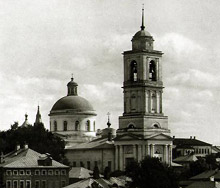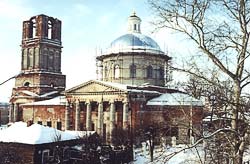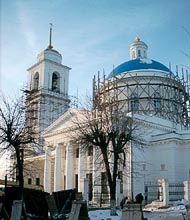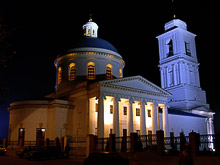|
|
Nikolsky Cathedral of Serpukhov
("Nikola Belyi"("White Nikola"))
The church of Nikola Belyi takes the first place by artistic dignities as well as by its town-planning meaning (it serves as the main high-rise dominant for the whole district of old historically made building up) among the monuments of architecture of late classicism in Serpukhov.
Nikolsky church at Kalyzhskaya Street has a long and complicated building history. Firstly it was wooden, as it appears in the documents of XVI — the beginning of XVII centuries (particularly in the schedule of Serpukhov of 1552 and 1620). "Only the church in the name of Nikolay the Miracle-worker in 1649 is already stone, that's why it is called "Nikola Belyi"... It was the first stone church in the city; the second was built in the village in the name of Women the Chrism-bearers, than the third stone cathedral was the Cathedral in the name of Holy Trinity in 1696" — as we read in the History of Serpukhov of P. Simson.
It was said that the architects from Yaroslavl took part in the building of the first stone church in the name of Nikolay the Miracle-maker, the forerunner of todays. The supposition is based on the similarity of compositional construction of the building that we can see from the retained ancient painting, with characteristic peculiarities of Yaroslavl's religious buildings of XVII century.
In 1713 an edict about the building of a new church in the name of St. Nikolay is issued. The initiator of the building was a clerk of Serpukhov's Zemskaya izba Mikhail Popov. In March of 1721 Mikhail Popov writes: "... and now I have built a stone church instead of that old and the head of the church made rightly". The church was consecrated the same year.
The church was a four accomplished by a dome with an altar addition that had symmetrically situated hipped completions above the altar. The building was made of hewn local limestone. That's why the church is called "Nikola Belyi". The monument existed in such view until the 30-s of XIX century.
In 1831 a plan of the church's rebuilding was composed. The plan's drafts with facades and cuts behind the signatures: architect Tamansky and architect Shestakov, retained. As the initials of both architects are lacking in the signatures on the draft papers, here comes the question about the indetification of these persons with other "stone masters" who are known to the historians of Russian architecture.
| Photographer: Michael Mamaev |
There is the data about three Tamanskys and six Shestakovs in the gathered by Diakonov materials to the dictionary of architects of XVIII-XIX centuries who worked in Moscow and in Podmoscovie. However, from the close acquaintance with their biographies we can see that only two of them could make the signatures in the plan's drafts in 1831: Theodore Mikhailovich Shestakov (who was born in 1787 and dead in 1836; an academician of the Imperial Academy of Arts, who planned many religious buildings for Moscow, Kolomna, Dmitrov and so on) and Ivan Trofimovich Tamansky (who was born in 1775, dead in 1850, was the pupil of M.F. Kazakov, worked in Moscow, but always went away to the different places of Moscow province).
In 1835 the building of the present church in the name of St. Nikolay with the altars in the name of St Aleksy, the Metropolitan of Moscow and St. Kirill Beloezersky began.
The church of Nikola Belyi that was built in 1835-1857 is a beautiful pattern of Moscow Empire style. It is built of brick and plastered and has white-stone details in the external decor. A powerful four with one apse and two side vestibules-porticos has a large dome rotunda. A four-pillared refectory and multi-storeyed bell tower that are connected to the basic capacity in the west faced some changes during their building in comparison with the plan.
After the revolution of 1917 the serving life in the church of Nikola Belyi stopped not immediately. St Tikhon visited the church on 2 June, 1924. He was the person, the Patriarchy of the whole Russia, who gave the church the name of the Cathedral, after that the meaning of Nikola Belyi in the city grew. In 1928 during the church split, the chair of Serpukhov's bishop Manuil (Lemeshevsky), who fought with it, was situated in Nikolsky Cathedral. It's also known that after closing of Vladychny women monastery the icon of the Blessed Virgin "The Non-drunk Chalice" respected in the city, was situated in Nikola Belyi. However the fare of many Serpukhov churchs overtook it, in 1929 it was closed. By stories of old residents the icons of the church were brought to the river Nara and burnt there.
The dislike to the church, blasphemously grown in people by new powers, let itself know here also: the bell tower, that raised high nobly above the city from the middle of XIX century, was partly destroyed; the icon of St. Nikolay at the outer wall of the church was always exposed to outrages. But as the dwellers of the houses situated closely to the church say, the icon renewed every morning showing God's power and foretelling a new life to the cathedral.
In some sense the Cathedral appeared to be happier than other churchs. For a period of time a macaroni factory was situated there, that must have saved it from final destroying. During the war the laundries were situated here. Lately before the opening the church was used as a chemical storehouse that was situated in the cathedral by Kudryakov's (the president of city's executive committee) initiative with the main purpose — to overcome the demolition of the church — such suppositions had a place to be!
On the eve of 1000 years of Russia's christening the Cathedral of Nikola Belyi as the brightest architectural monument was spoken about again.Among the plans of church's use the possibility of its turning to the concert hall was also examined. But by God's mercy in 1995 it was given back to believers as a town church of Vysotsky monastery, from 1998 — a parish church. In 1995 city's administration gave Holy Patriarchy Aleksy II the keys from the church during his staying in Serpukhov. In 1999 with the help of the means of benefactors, city's administration and city dwellers the bells were bought. A bell that is 1380 kg in weight has four icons-brands: of Saviour, the Blessed Virgin, St Nikolay the Miracle-maker and the icon of St. Yuvenaliy Patriarchy of Jerusalem. A bell of 300 poods sounds at the restored bell-tower.
On 12 July 2005 the great consecration of the Cathedral was made by Yuvenaliy the Metropolitan Krutitsky and Kolomensky.
A miracle-working icon of the Blessed Virgin "The Help in the delivery" to which the services with the acathistus, composed by the senior priest of the cathedral Vladimir Andreev, and the icons of Nikolay Miracle-maker and m. Vonifaty.
There is a library attached to the Cathedral and Sunday schools: for children and adults. The clergy of the cathedral is lead by Serpukhov Military Institute, investigatory cell, an orphanage and a hostel.
The rebirth of the Cathedral with the help of the whole city is a memorable sign of our soul rebirth. The bell tower is raising high above the city again, and the bells awake our sleeping souls, turning them to charity, penance and rebirth of our life.
Clergy: archpriest Vladimir Andreev — the senior priest, priest Oleg Zhurba, priest Alexy Filatov, priest Valery Gololobov, deacon Alexy Spigin
Phone: +7 (4967) 72-49-17
Address: Moscow district, Serpukhov, Kaluzhskaya Street, 26/12
Thoroughfare: from Kursky railway station to st. "Serpukhov", then by any bus to st "Chekhov Street"





